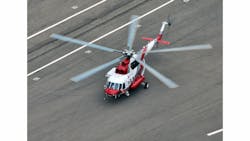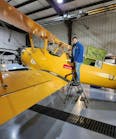Russian Helicopters (part of State Corporation Rostec) has launched flight tests on the first prototype of the multirole Mi-171A2 helicopter. During its first flight its main systems were tested and found to be in excellent working order, according to commander and test pilot 1st class Salavat Sadriev.
The first prototype of the Mi-171A2 was designed for tests on its in-flight operability and safety when using the KBO-17 avionics suite, including its interoperability with the new VK-2500PS-03 engines, and to test the new powerplant. The first Mi-171A2 prototype has been subjected to ground runs, which passed off smoothly and led to the first successful tests in hover mode in October 2014. The new helicopter's rotor system and engine were tested by the special 'flying laboratory' - Mi-171LL.
The KBO-17 avionics suite is built by Radioelectronic Technologies to a 'glass cockpit' design, and includes all-weather digital TV and thermal imaging cameras, delivering external visibility day or night, with the video output given on a high-resolution multifunction display. The high degree of automation has made it possible to cut crew numbers from three to two people. The on-board maintenance systems built in to the KBO-17 make it possible to monitor the condition of the helicopter's main systems and components, storing this data in its memory.
The first round of tests on the 'flying laboratory' delivered a 20% increase in cruising and maximum speeds, increased main rotor thrust (by more than 800 kilograms), reduced vibration from the standard vibration dampener. The maximum speed was confirmed as being 280 km/hour.
A range of alterations in construction, including new main and tail rotors, smoother vertical and horizontal fins, will be incorporated into the second prototype of the Mi-171A2. The second test prototype will be equipped with an additional range of equipment options: an external sling for up to 5 tonnes and weight measurement system; air-conditioning system, energy absorbing passenger seats for 24 people, and anti-dust equipment that cleans air to 97%. This model is currently being assembled and equipped at the Mil Moscow Helicopter Plant.
The Mi-171A2 was developed by Mil Moscow Helicopter Plant, part of Russian Helicopters. Many of the solutions developed during design work on the Mi-171A2 have been incorporated into other helicopters in the Mi-8/17 family, which has long helped ensure they meet the latest international standards.
The Mi-171A2 is one of the most eagerly awaited developments in Russian helicopter building. The helicopter represents the future of the world-famous Mi-8/17 helicopter, with significant changes to its design and on-board equipment that improve its flight capabilities and reduce operational costs. The main differences between the Mi-171A2 and previous models are:
- New, more powerful and more economic Klimov VK-2500PS-03 engines, boasting BARK-6V-7C digital regulation and control systems;
- New main rotor boasting composite blades, improved aerodynamics and X-type antitorque;
- Fundamentally new radio-electronic systems integrating pilot and navigation suite with open-architecture KBO-17, developed at the Ulyanovsk Instrument Design Bureau, part of Radioelectronic Technologies.
The Mi-171A2 can be operated at any time of day or night, including in difficult weather conditions, can work in hover mode and with automatic stabilisation, and can also fly on special trajectories.
Video of the Mi-171A2 first flight: http://youtu.be/_8QqDUnUUBc
Mil Moscow Helicopter Plant is a subsidiary of Russian Helicopters. Its key areas of activity are experimental research and design, and the design, construction and testing of prototype helicopters. Since its founding, the Plant has created 12 basic models of helicopter, including the Mi-8/17, Mi-35M, Mi-26, Mi-28, Mi-38 and numerous modifications. Mi-helicopters are in operation in 110 countries worldwide and form the backbone of helicopter aviation in Russia, the CIS, as well as in countries in Asia, Latin America, Africa and the Middle East.
Concern Radio-Electronic Technologies, JSC (KRET) is the largest Russian company in radio-electronic industry. It was founded in 2009. It is a part of the State Corporation Rostec. Its main activities: development and production of systems and complexes of the onboard avionics for civil and military aircrafts, radars air-launched, IFF and EW systems, measuring instruments for various applications, electrical connectors and cables. In addition, enterprises of the Group are producing modern household appliances, medical equipment, equipment and control systems for fuel and energy complex, transport and engineering. The Group includes 97 research institutes, design offices and factories located in 29 constituent entities of the Russian Federation. Number of employees: approximately 50 000 people.
Russian Helicopters, (part of State Corporation Rostec), is one of the global leaders in helicopter production and the only helicopter design and production powerhouse in Russia. Russian Helicopters was founded in 2007 and is headquartered in Moscow. The company comprises five helicopter production facilities, two design bureaus, a spare parts production and repair facility, as well as an aftersale service branch responsible for maintenance and repair in Russia and all over the world. Its helicopters are popular among Russian ministries and state authorities (Ministry of Defence, Ministry of Internal Affairs, Emergency Control Ministry), operators (Gazpromavia, UTair), major Russian corporations. In 2013 its IFRS revenues increased 10% to RUB 138.3 billion. Deliveries reached 275 helicopters.
State Corporation Rostec is a Russian corporation founded in 2007 for the purpose of promoting the development, production and export of hi-tech civilian and military industry products. It comprises 700 organisations, nine of which have now been formed as holding companies of the military-industrial complex and five of them are involved in civil industries. Rostec's organisations are located in 60 constituent entities of the Russian Federation and supply their products to the markets of more than 70 countries. The revenue of Rostec in 2013 amounted to RUB 1, 04 trillion, with net profit of RUB 40 billion. The tax deductions into the treasuries at all levels exceeded RUB 138 billion

